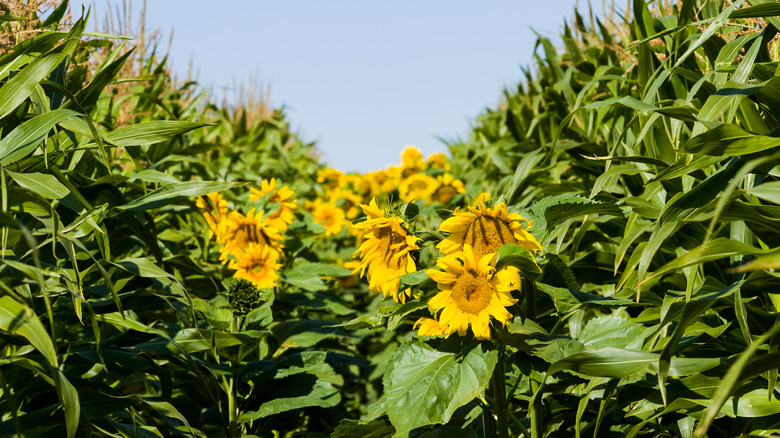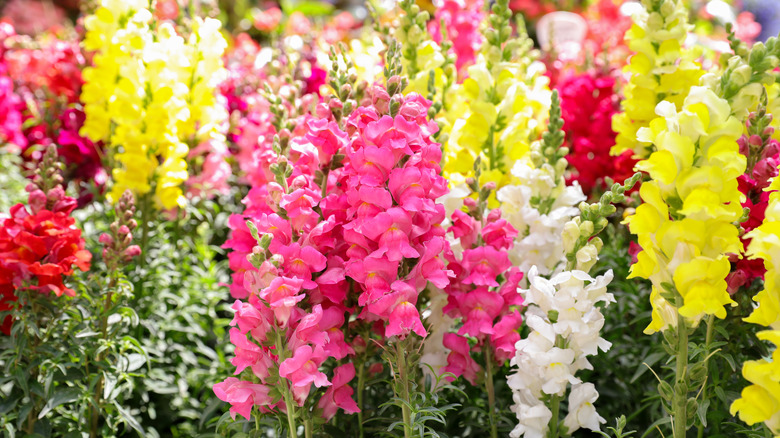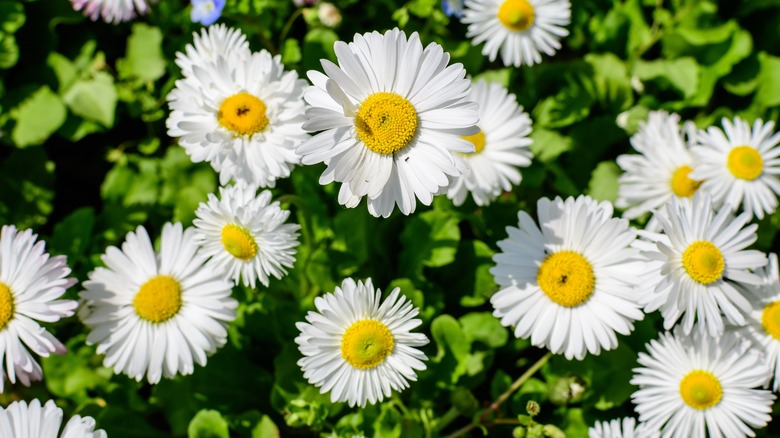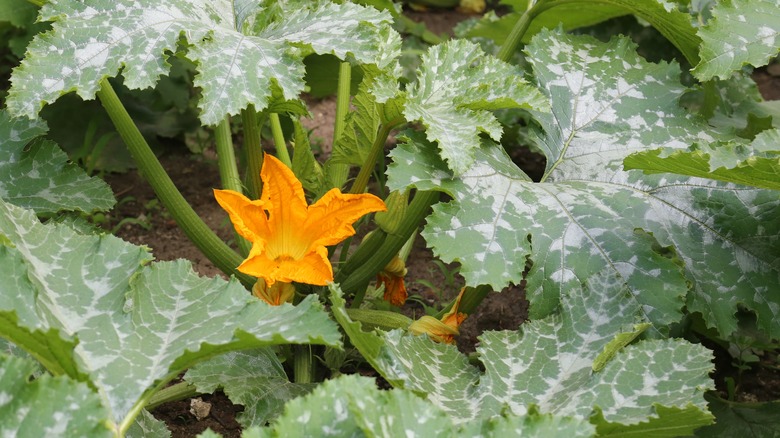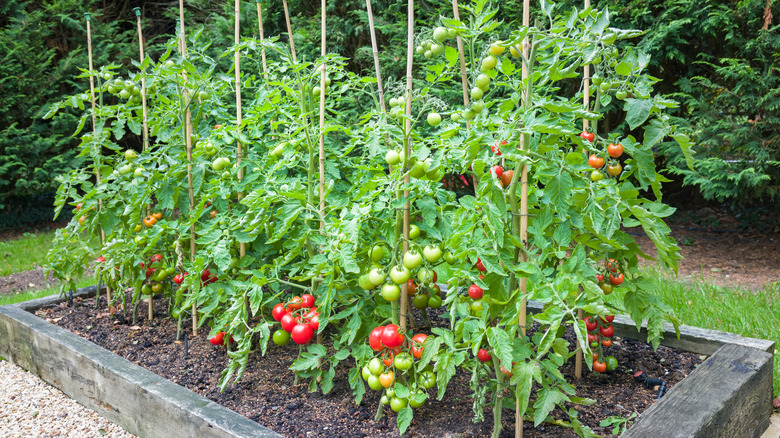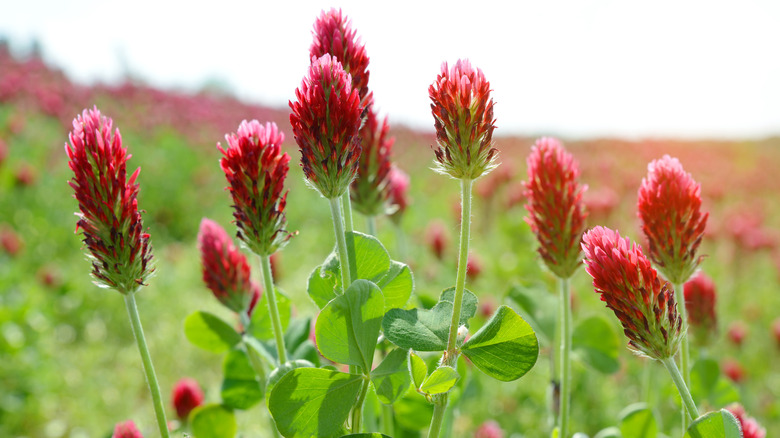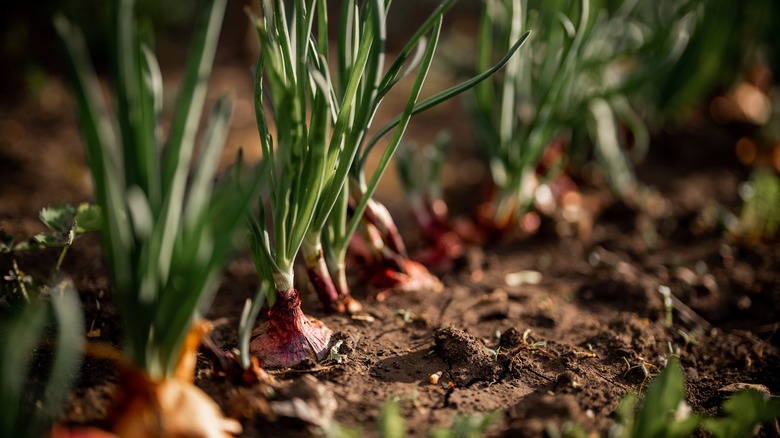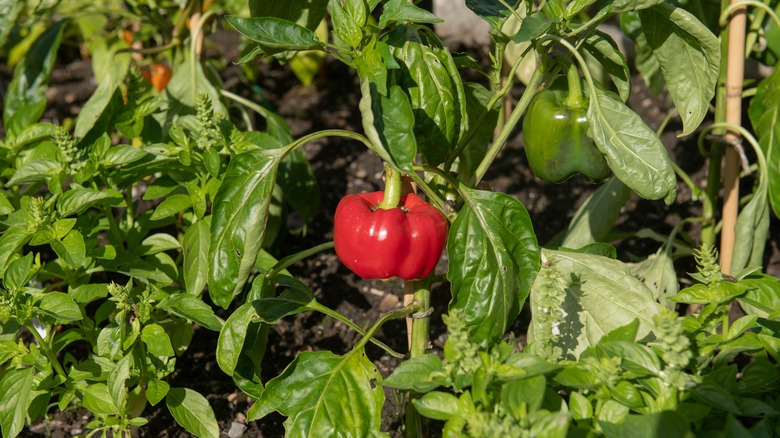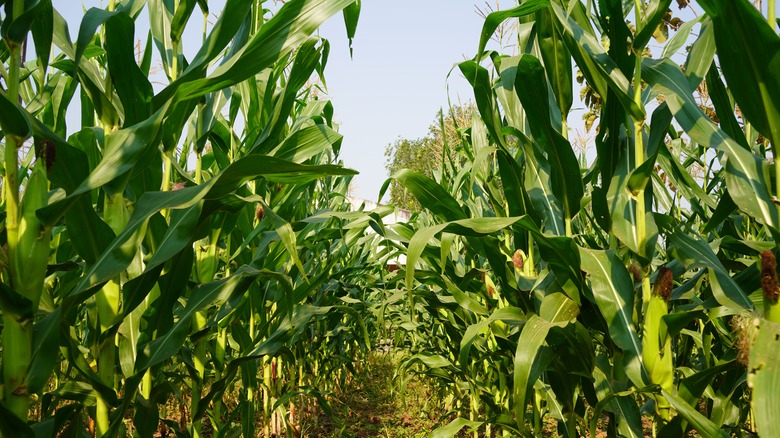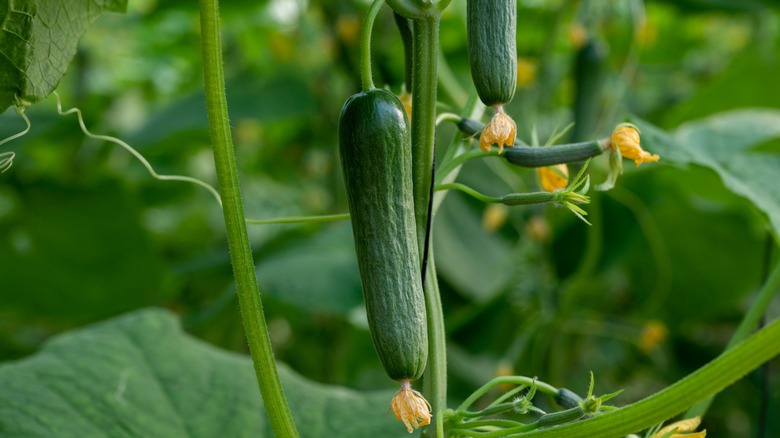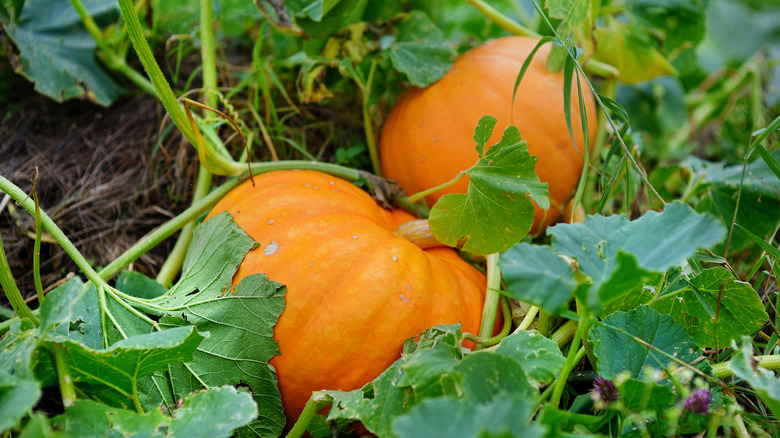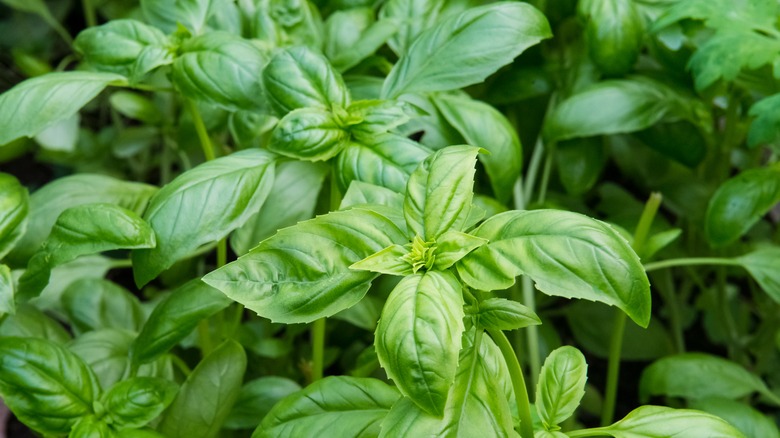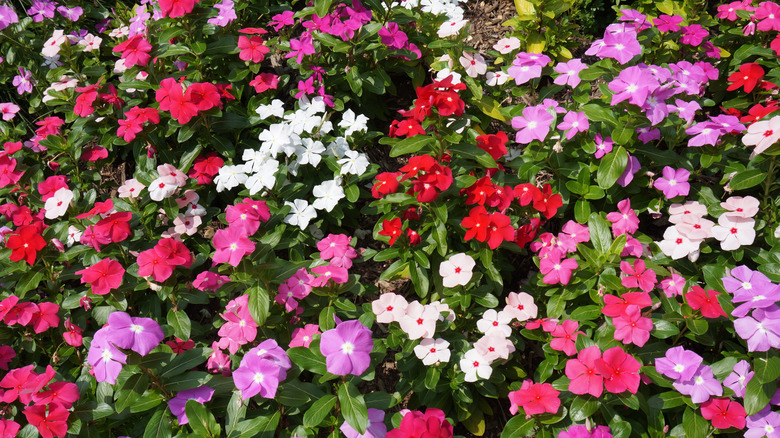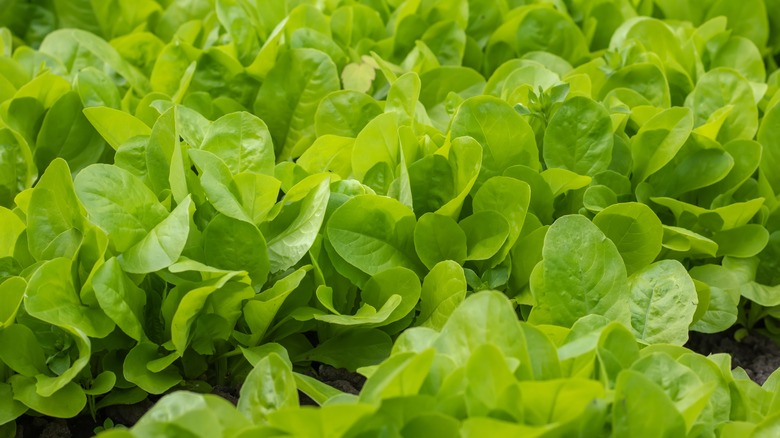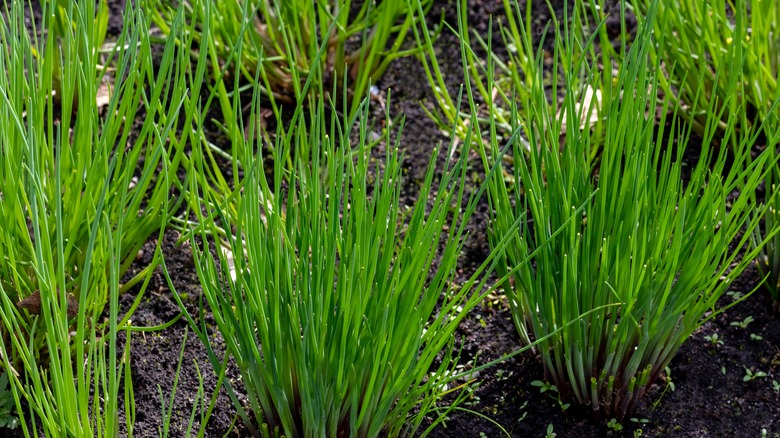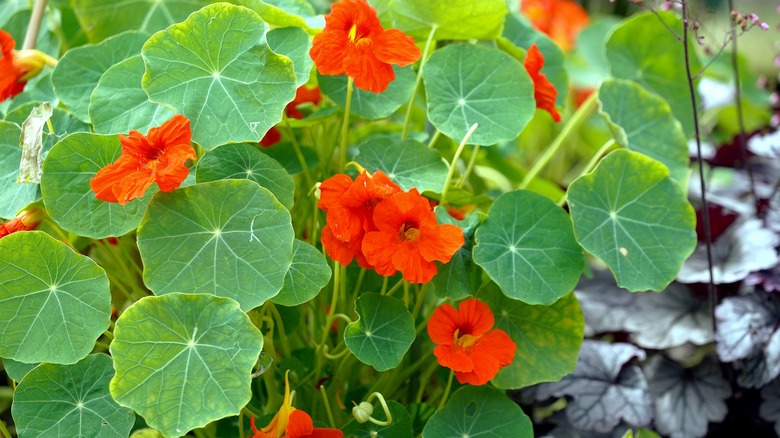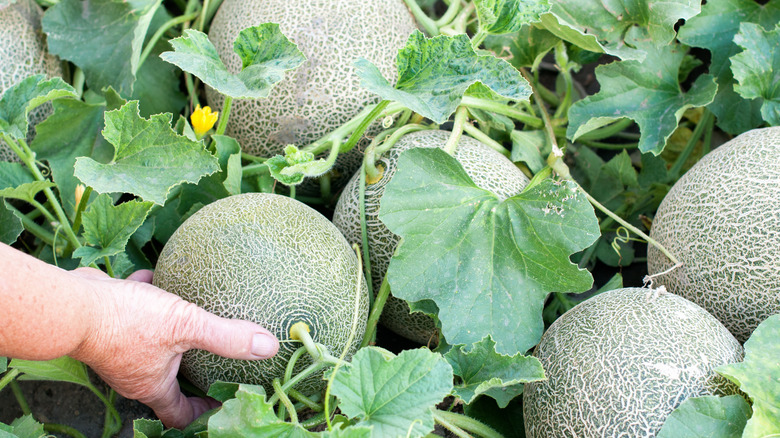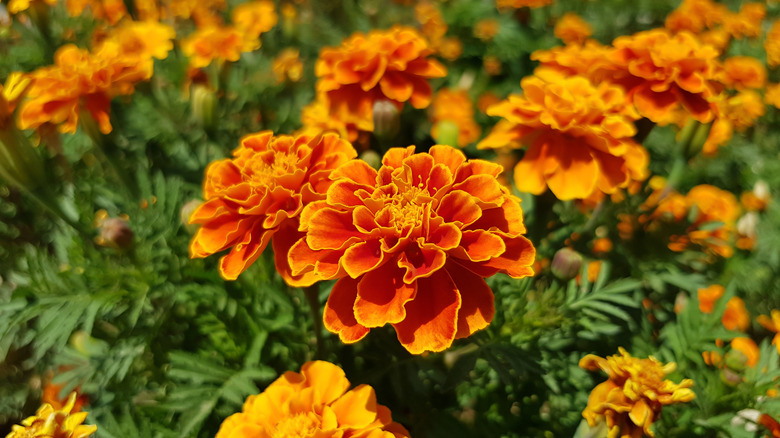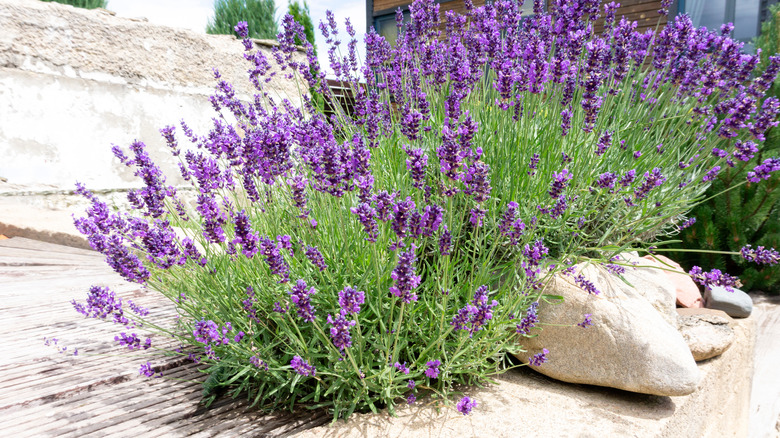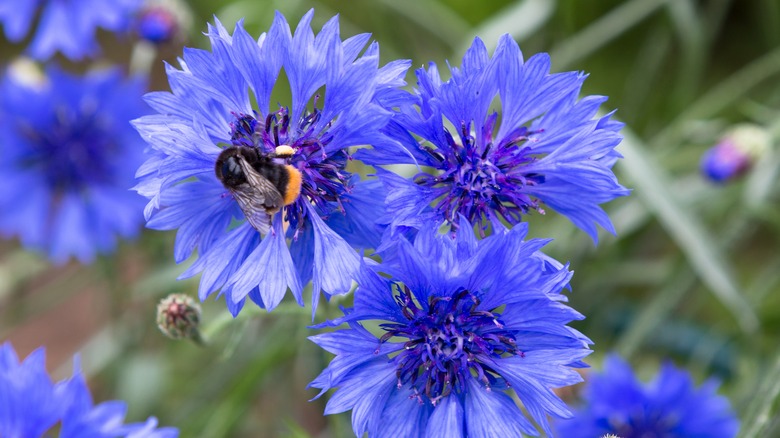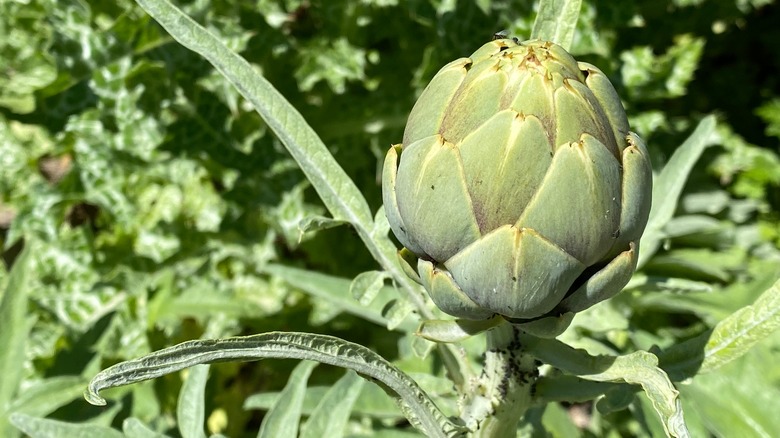Companion Plants That Will Thrive Alongside Sunflowers
If you could do one small thing to ensure your plants grew faster, larger, or more healthily, would you do it? We think most gardeners, even at the beginning of their journey, absolutely would. Which brings us to companion planting, a practice where plants are planted together for mutual benefit. By using each plant's natural abilities to attract pollinators, repel pests, and/or enhance the soil they share with others, we can grow better crops and flowers that require less maintenance. Take sunflowers, for example. There are a variety of companion plants that will thrive when planted alongside these large, happy flowers, while also lending an assist to the sunflowers and their growth as well.
Sunflowers have many companion plants that benefit from their tall growth and ability to attract bees and beneficial insects. Of course, these companions sometimes help the sunflowers, too. Often, they shield the soil from weeds, erosion, and drying sunshine, or they keep away hungry animals that like to snack on sunflower leaves and seeds. If you love growing sunflowers, herbs, and vegetables in your backyard, consider adding one or more of the following plants to increase your garden's productivity and overall health.
1. Snapdragons
Snapdragons (Antirrhinum majus) are gorgeous flowering plants that grow best in the sun with some shade. Planting them nearby sunflowers will provide them with shade, especially on bright days. The shade, along with more pollinators being drawn in, helps keep the snapdragons looking better for longer, and the two also pair wonderfully together for a colorful garden.
Bloom Season: Spring to fall
USDA Growing Zone: 2 to 11
Growing Conditions: Full sun to partial shade
Soil Type: Evenly moist and well-draining
Size: 6 inches to 3 feet tall, depending on the cultivar
2. English daisies
English daisies (Bellis perennis) are well-known flowers that are grown for their identifiable white petals and yellow centers. Like snapdragons, these dainty blooms prefer some shade during the hot summer months. The sunflowers, which require full sun, soak up the rays and protect the daisies so that they can bloom together for many months.
Bloom Season: Summer
USDA Growing Zone: 4 to 8
Growing Conditions: Full sun to partial shade
Soil Type: Evenly moist, fertile, and well-draining
Size: 3 to 6 inches tall and 3 to 9 inches wide
3. Zucchini
Zucchini (Cucurbita pepo), a sibling to common squash varieties, is among the most popular vegetables in the Cucurbita genus. They're usually not too challenging to grow in a backyard garden, except they can become quite large in short order. However, when grown alongside sunflowers as companions, they can climb the sunflowers as a trellis, which helps manage their long vining stems.
Bloom Season: Summer
USDA Growing Zone: 3 to 11
Growing Conditions: Full sun
Soil Type: Evenly moist and well-draining
Size: 1 to 3 feet tall and 2 to 25 feet wide
4. Tomato
Tomatoes (Solanum lycopersicum) attract a range of insects that can be detrimental to the plant, including tomato hornworms, tomato fruit worms, flea beetles, cutworms, whiteflies, and stink bugs. Planting sunflowers nearby can help control the number of stink bugs preying on your precious tomatoes, as the flower will act as a "trap plant." While the bugs are getting full on the sunflowers, your tomatoes will be protected.
Bloom Season: Summer
USDA Growing Zone: 10 to 11
Growing Conditions: Full sun
Soil Type: Well-draining
Size: 3 to 6 feet tall and 2 to 3 feet wide
5. Crimson clover
Crimson clovers (Trifolium incarnatum) are easy-going flowering plants that feature red flowers on top of green stems with clover-like leaves. The plant is favored for its low-maintenance habit along with its ability to improve your soil. They help keep weeds away from vulnerable plants, and they control soil erosion. On top of that, crimson clovers also attract pollinators and other beneficial insects that help sunflowers mature healthily.
Bloom Season: Summer to fall
USDA Growing Zone: 1 to 10
Growing Conditions: Full sun to partial shade
Soil Type: Well-draining
Size: 24 to 36 inches tall
6. Onion
Onions (Allium cepa) and sunflowers can make good companions. They don't attract any of the same pests, so you don't have to worry about a bad infestation. They also bear a strong scent that many pests and scavenging animals dislike. Oftentimes, growing onions near plants that attract birds, deer, rabbits, or certain pests will keep predators away as they mask the scent of the more palatable plant.
Bloom Season: Summer
USDA Growing Zone: 5 to 10
Growing Conditions: Full sun
Soil Type: Organic and well-draining
Size: 30 inches tall and 1 foot wide
7. Peppers
Sweet and spicy peppers (Capsicum annuum) can be planted near sunflowers. As long as both species are provided with plenty of direct sunlight, the sunflowers can help the peppers in ways many other plants cannot. For one, bees and other pollinators are attracted to the sunflower, which helps to pollinate the peppers. Secondly, the flowers also lure in ladybird beetles that eat pests like aphids that commonly attack pepper plants.
Bloom Season: Summer
USDA Growing Zone: 4 to 11
Growing Conditions: Full sun
Soil Type: Well-draining
Size: 1 to 4 feet tall and 6 to 12 inches wide
8. Corn
Corn plants (Zea mays) are among the best companion plants for sunflowers. The two get along nicely because they normally don't have to compete for space, sunlight, or nutrients when planted correctly. Sunflowers can be planted between the rows to break up the soil and allow the corn to grow better. In short, planting the two together can enhance the growth of both plants.
Bloom Season: Summer
USDA Growing Zone: 2 to 11
Growing Conditions: Full sun
Soil Type: Fertile and well-draining
Size: 5 to 8 feet tall and 1 to 2 feet wide
9. Cucumbers
Cucumbers (Cucumis sativus), like zucchini, are rapidly growing and vining plants that can benefit from the use of a trellis to grow vertically. If you don't like the idea of installing a trellis in your garden for these green veggies, you might consider growing some sunflowers nearby for the cucumbers to climb.
Bloom Season: Summer
USDA Growing Zone: 2 to 11
Growing Conditions: Full sun
Soil Type: Evenly moist, fertile, and well-draining
Size: 8 to 18 inches tall and 3 to 8 feet wide
10. Pumpkin
Pumpkins (Cucurbita maxima) are an exciting crop to grow, and it's even better when they have a high yield come harvest time. One way to help your pumpkins thrive is to plant sunflowers close by. Doing so allows your pumpkin plants to become pollinated more easily as the sunflowers attract pollinators from a wider range due to their tall height.
Bloom Season: Summer
USDA Growing Zone: 2 to 11
Growing Conditions: Full sun
Soil Type: Moist and well-draining
Size: 9 to 18 inches tall and 10 to 12 feet wide
11. Basil
A versatile herb, basil (Ocimum basilicum) is a delicious and pungent plant that commonly experiences bolting when it's exposed to too much direct sunlight. Thanks to the tall growth habit of sunflowers, however, planting basil beneath them can help keep the growth of premature flower stalks to a minimum. Consider planting basil, sunflowers, and tomatoes together to reap the companion planting benefits that each provides.
Bloom Season: Summer to fall
USDA Growing Zone: 2 to 11
Growing Conditions: Full sun
Soil Type: Rich and well-draining
Size: 18 to 24 inches tall and up to 2 feet wide
12. Impatiens
Impatiens (Impatiens spp.) enjoy being planted under larger plants that can provide them with shade. Sunflowers are a great option for this as they can create a nice shady canopy for the plants below if planted in the right spot. The smaller flowers can also help the sunflowers when planted en masse. Covering the soil, they help to keep the ground cool and moist.
Bloom Season: Summer to fall
USDA Growing Zone: 10 to 11
Growing Conditions: Partial shade to full shade
Soil Type: Evenly moist, rich, and well-draining
Size: 6 to 24 inches tall and wide
13. Lettuce
Lettuce (Lactuca sativa) is a great edible plant to grow beneath sunflowers, especially during hot summers. A garden lined with the two species will look lush and beautiful, while also cutting out some of the maintenance work that you're used to. Planted together, sunflowers shade lettuce from the hot sun and attract beneficial insects that eat pests snacking on the delicious leaves.
Bloom Season: Summer
USDA Growing Zone: 2 to 11
Growing Conditions: Full sun to partial shade
Soil Type: Fertile, well-composted, and well-draining
Size: 6 to 12 inches tall and wide
14. Chives
Chives (Allium schoenoprasum), like onions, are a member of the Allium genus and boast a light flavor reminiscent of garlic or onions. Due to their minimal nutrient needs and shallow root system, chives grow well with sunflowers. In addition to this, while the sunflowers share their pollinators with the veggie, pests and predators are warded off from the pungent smell of the Allium species.
Bloom Season: Spring and summer
USDA Growing Zone: 3 to 9
Growing Conditions: Full sun
Soil Type: Rich and well-draining
Size: 12 to 18 inches tall and 12 to 18 inches wide
15. Nasturtiums
Nasturtiums (Tropaeolum spp.) are wonderful companion plants for several species, including radishes, broccoli, squash, tomatoes, and more. They're frequently planted as trap crops to attract a variety of pests away from the vegetables mentioned previously. However, when planted alongside sunflowers, they're used to attract beneficial insects and pollinators. They also effectively keep moisture in the soil and weeds away when grown in larger sections.
Bloom Season: Summer to fall
USDA Growing Zone: 2 to 11
Growing Conditions: Full sun
Soil Type: Slightly acidic and well-draining
Size: 1 to 10 feet tall and 1 to 3 feet wide
16. Melon
Grown on a large vining plant, melons (Cucumis melo) cover the ground which can help manage weeds and drying of the soil below. Because of this, young sunflowers grown nearby can mature easily without a fight. As the sunflowers grow up, the relationship switches when the melons begin climbing the tall stalks, and receive help from the pollinator-attracting flowers.
Bloom Season: Summer
USDA Growing Zone: 2 to 11
Growing Conditions: Full sun
Soil Type: Loose, moist, rich, and well-draining
Size: 6 to 9 feet tall and 1 to 3 feet wide
17. French marigolds
Like nasturtiums, French marigolds (Tagetes patula) can act as mulch when planted under the canopy of sunflowers. The two types of yellow flowers undeniably grow well together and look good as they do so. French marigolds are also a valuable pest deterrent that keeps harmful insects away from sunflowers and anything else growing close by. Despite this, the blooms still attract pollinators, which the sunflowers and French marigolds both benefit from.
Bloom Season: Spring to fall
USDA Growing Zone: 2 to 11
Growing Conditions: Full sun to partial shade
Soil Type: Well-draining
Size: 6 to 12 inches tall
18. Lavender
Lavender (Lavandula angustifolia) and sunflowers are considered to be good companion plants because they both attract pollinators. Of course, both species bring in pollinators on their own, but twice the enticement isn't bad. Especially considering that both of them are important for the survival of declining species, such as starlings, hedgehogs, and bumblebees. Planting these together won't only provide you with bountiful blooms, but it also brings forth a buffet for native wildlife and insects.
Bloom Season: Summer
USDA Growing Zone: 5 to 8
Growing Conditions: Full sun
Soil Type: Average and well-draining
Size: 3 feet tall and wide
19. Cornflower
Cornflowers (Centaurea cyanus), also known as bluebonnets and bluets, are low-maintenance flowers that are commonly paired with sunflowers in bouquets, as the two bright flowers complement each other nicely. Even growing in the garden, these two species in their respective shades of blue and yellow stand out against one another. Consider growing cornflowers nearby your sunflowers to enjoy their colors, but also to reap the pollination benefits that one offers to the other.
Bloom Season: Spring and summer
USDA Growing Zone: 2 to 11
Growing Conditions: Full sun
Soil Type: Well-draining
Size: 1 to 3 feet tall and wide
20. Artichoke
Artichokes (Cynara cardunculus var. scolymus) grow best in temperate climates without strong winds or extreme sunshine. And, despite being native to Chile and Ecuador, where temperatures are consistently warm, artichokes actually prefer cool summers. Grown with sunflowers, artichokes are protected from winds and strong sunlight. The two won't compete for space or nutrients, and you can make a delicious artichoke sunflower dip come harvest time.
Bloom Season: Spring
USDA Growing Zone: 7 to 10
Growing Conditions: Full sun to partial shade
Soil Type: Fertile, moist, and well-draining
Size: 3 to 5 feet tall and 2 to 3 feet wide

